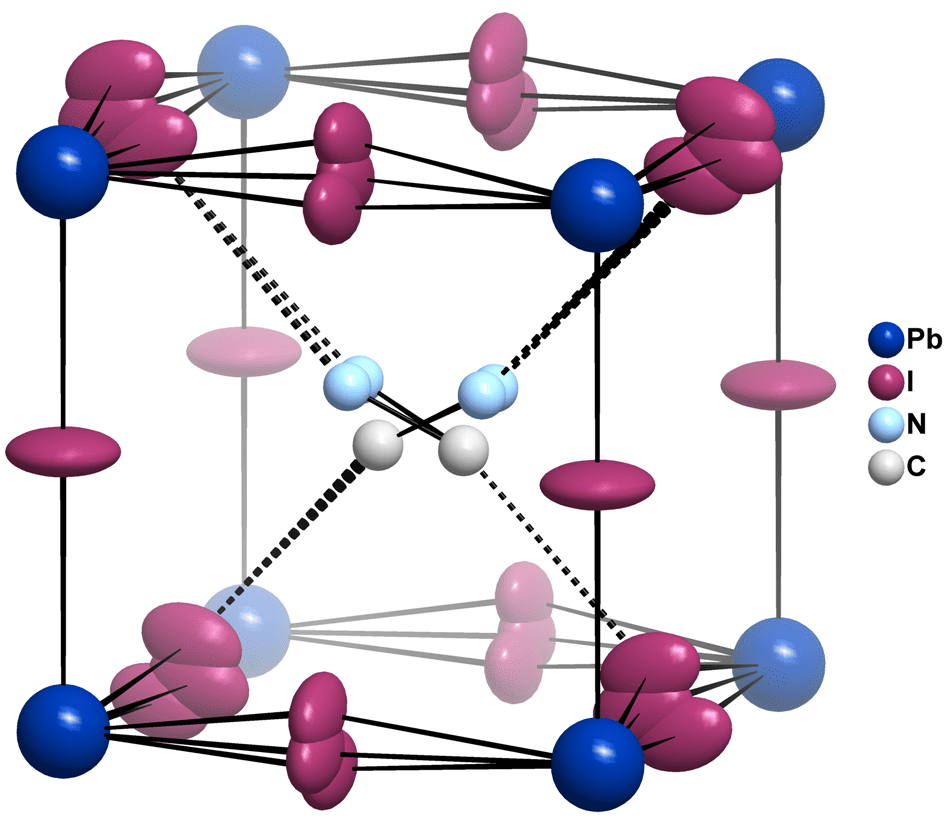Nov 14 2019
Researchers at Helmholtz-Zentrum Berlin (HZB) have successfully demonstrated that hybrid halide perovskites crystallize without an inversion center. The HZB team discovered this phenomenon through crystallographic analyses at the Diamond Light Source (DLS) synchrotron in the United Kingdom.
 The drawing illustrates the interaction of the organic methylammonium cation (CH3NH3+) with the surrounding iodide ions. The shift of the iodide atoms out of the common plane with lead causes the breaking of the inversion symmetry. Image Credit: © HZB.
The drawing illustrates the interaction of the organic methylammonium cation (CH3NH3+) with the surrounding iodide ions. The shift of the iodide atoms out of the common plane with lead causes the breaking of the inversion symmetry. Image Credit: © HZB.
When organic molecules interact with neighboring iodine atoms, ferroelectric domains are formed that, indirectly, can lead to higher solar-cell efficiencies. However, these ferroelectric domains cannot form in purely inorganic perovskites.
Perovskite-based solar cells have achieved extremely high efficiencies within a span of just a few years. Solar cells containing hybrid halide perovskite, that is, materials comprising both organic and inorganic components, reach specifically high efficiencies, but do not have long-term stability.
Although inorganic perovskite semiconductors, like CsPbI3, are less efficient, they are also believed to be interesting, because they could resolve the stability problems relating to hybrid perovskites.
In-Depth Crystal Structure Analysis
So far, it was believed that pure and hybrid inorganic perovskites have almost the same crystalline structure. But when creating perovskite materials, an infinite number of tiny twin crystals are formed instead of large single crystals. This makes a crystal structure analysis specifically challenging and is likely to result in errors and reduced accuracy.
The HZB research team, led by Professor Susan Schorr and Dr Joachim Breternitz, has currently moved a step forward in interpreting the crystalline structure of these hybrid halide perovskites.
At the Diamond Light Source synchrotron (DLS) in the United Kingdom, the researchers studied the crystalline samples of methylammonium lead iodide (MAPbI3) using high-resolution single-crystal diffraction. MAPbI3 is the most notable representative of this group of materials. This method offered data for a more detailed analysis of this material’s crystalline structure.
Ferroelectric Domains
The researchers also verified whether ferroelectric effects could indeed be achieved in this hybrid halide perovskite. Ferroelectric domains can have favorable impacts on solar cells and boost their efficiency. But it is difficult to quantify this effect in samples; here, a null result can imply two things—either there is no ferroelectric effect or the ferroelectric domains cancel out the effects of one another.
No Inversion Center in MAPbI3
From a crystallographic point of view, some conditions are necessary for ferroelectricity: a ferroelectric effect can only occur if the crystal structure does not contain an inversion centre, and additionally if it exhibits a permanent polar moment.
Dr Joachim Breternitz, Chemist, Department Structure and Dynamics of Energy Materials, HZB
Earlier, it was believed that MAPbI3’s crystal structure did contain an inversion center. But the outcomes of the crystal structure analysis demonstrated that this is not the case.
The organic methylammonium cation MA+ plays a major role in this.
Dr Joachim Breternitz, Chemist, Department Structure and Dynamics of Energy Materials, HZB
The reason is that the MA molecule is significantly larger than one atom and is not spherically symmetrical. Hence, it produces a polar moment with the neighboring iodine atoms. Therefore, ferroelectric domains are likely to occur in MAPbI3.
Fundamental Difference Between Hybrid and Inorganic Perovskites
However, this mechanism does not apply to inorganic perovskites containing an alkali atom rather than the MA molecule. This means that more stable inorganic perovskites may essentially have slightly reduced efficiency when compared to their hybrid halide cousins.
The study has been reported in Angewandte Chemie (2019), titled “Role of the Iodide–Methylammonium Interaction in the Ferroelectricity of CH3NH3PbI3.” Study authors include J. Breternitz, F. Lehmann, S. A. Barnett, H. Nowell, and S. Schorr.